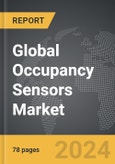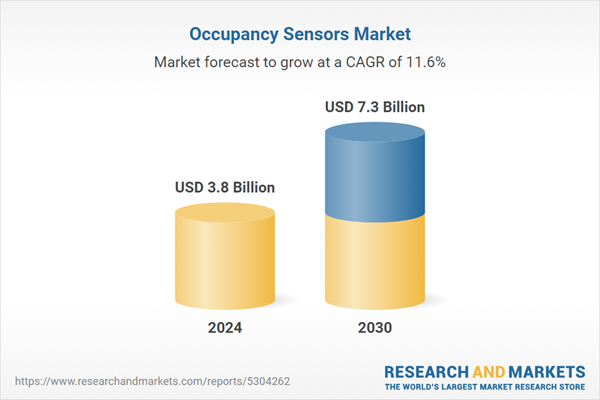Global Occupancy Sensors Market - Key Trends and Drivers Summarized
How Are Occupancy Sensors Transforming Building Automation?
Occupancy sensors are becoming an integral part of building automation systems, providing real-time data about the presence or absence of people in a space. These sensors are used to optimize lighting, heating, ventilation, and air conditioning (HVAC), improving energy efficiency and reducing operational costs. Technologies such as passive infrared (PIR), ultrasonic, and microwave sensors detect movement, while newer sensors also incorporate thermal imaging and AI algorithms to enhance accuracy. As sustainability becomes a priority in commercial and residential buildings, occupancy sensors are playing a crucial role in energy management, enhancing both the environmental and economic performance of smart buildings.What Are the Key Segments in the Occupancy Sensors Market?
Major technologies include passive infrared, ultrasonic, and dual-technology sensors, with passive infrared sensors dominating the market due to their cost-effectiveness and reliability in detecting motion. The building type segment covers residential, commercial, and industrial settings, with commercial buildings representing the largest segment due to higher energy consumption and greater focus on energy efficiency. In terms of application, occupancy sensors are widely used in lighting control, HVAC systems, and security systems, where they help in energy savings, efficient space utilization, and enhanced safety.How Are Occupancy Sensors Being Adopted Across Industries?
In commercial buildings, occupancy sensors are primarily used for automatic lighting control, turning lights on or off based on room occupancy to save energy. These sensors are also integrated into HVAC systems to adjust airflow and temperature based on occupancy patterns, improving both comfort and energy efficiency. In residential buildings, occupancy sensors are employed in smart home systems, enabling homeowners to manage lighting, heating, and security more efficiently. Industrial facilities use occupancy sensors to monitor production areas and manage lighting in warehouses, thereby enhancing safety and reducing energy consumption. Additionally, educational institutions, healthcare facilities, and public infrastructure are increasingly adopting occupancy sensors to meet green building standards and reduce operational costs.What Factors Are Driving the Growth in the Occupancy Sensors Market?
The growth in the Occupancy Sensors market is driven by several factors, including the increasing focus on energy efficiency and sustainability in buildings. Rising energy costs and stringent regulations for energy conservation have prompted commercial and residential building owners to adopt smart solutions like occupancy sensors. Advancements in sensor technology, such as AI integration and thermal imaging, have improved detection accuracy and expanded applications. The growth of smart cities and building automation systems has also boosted demand for occupancy sensors. Additionally, government incentives for green buildings and retrofitting projects in developed regions are further supporting market expansion. The rising adoption of IoT and connected devices in smart homes is also contributing to the growing demand for occupancy sensors globally.Report Scope
The report analyzes the Occupancy Sensors market, presented in terms of market value (US$ Thousand). The analysis covers the key segments and geographic regions outlined below.- Segments: Technology (Passive Infrared, Ultrasonic, Dual Technology, Other Technologies); Network Connectivity (Wired, Wireless); Application (Lighting Systems, HVAC Systems, Security & Surveillance Systems, Other Applications).
- Geographic Regions/Countries:World; United States; Canada; Japan; China; Europe (France; Germany; Italy; United Kingdom; Spain; Russia; and Rest of Europe); Asia-Pacific (Australia; India; South Korea; and Rest of Asia-Pacific); Latin America (Argentina; Brazil; Mexico; and Rest of Latin America); Middle East (Iran; Israel; Saudi Arabia; United Arab Emirates; and Rest of Middle East); and Africa.
Key Insights:
- Market Growth: Understand the significant growth trajectory of the Passive Infrared Technology segment, which is expected to reach US$4.8 Billion by 2030 with a CAGR of a 11.3%. The Ultrasonic Technology segment is also set to grow at 12.4% CAGR over the analysis period.
- Regional Analysis: Gain insights into the U.S. market, valued at $962.7 Million in 2024, and China, forecasted to grow at an impressive 15.2% CAGR to reach $1.7 Billion by 2030. Discover growth trends in other key regions, including Japan, Canada, Germany, and the Asia-Pacific.
Why You Should Buy This Report:
- Detailed Market Analysis: Access a thorough analysis of the Global Occupancy Sensors Market, covering all major geographic regions and market segments.
- Competitive Insights: Get an overview of the competitive landscape, including the market presence of major players across different geographies.
- Future Trends and Drivers: Understand the key trends and drivers shaping the future of the Global Occupancy Sensors Market.
- Actionable Insights: Benefit from actionable insights that can help you identify new revenue opportunities and make strategic business decisions.
Key Questions Answered:
- How is the Global Occupancy Sensors Market expected to evolve by 2030?
- What are the main drivers and restraints affecting the market?
- Which market segments will grow the most over the forecast period?
- How will market shares for different regions and segments change by 2030?
- Who are the leading players in the market, and what are their prospects?
Report Features:
- Comprehensive Market Data: Independent analysis of annual sales and market forecasts in US$ Million from 2024 to 2030.
- In-Depth Regional Analysis: Detailed insights into key markets, including the U.S., China, Japan, Canada, Europe, Asia-Pacific, Latin America, Middle East, and Africa.
- Company Profiles: Coverage of players such as Acuity Brands, Cooper Industries Inc, Eaton Corporation plc, General Electric Company, Honeywell International, Inc. and more.
- Complimentary Updates: Receive free report updates for one year to keep you informed of the latest market developments.
Some of the 12 companies featured in this Occupancy Sensors market report include:
- Acuity Brands
- Cooper Industries Inc
- Eaton Corporation plc
- General Electric Company
- Honeywell International, Inc.
- Hubbell Incorporated.
- Johnson Controls Inc.
- Koninklijke Philips N.V.
- Legrand
- Leviton Manufacturing Company
- Lutron Electronics
- Lutron Electronics Co, Inc.
- Pammvi Group
- Panasonic
- Pepperl+Fuchs
- Schneider Electric
- Shenzhen Teng smart science and technology limited company
- Telkonet
- Texas instruments Ltd
- Veris Industries
This edition integrates the latest global trade and economic shifts into comprehensive market analysis. Key updates include:
- Tariff and Trade Impact: Insights into global tariff negotiations across 180+ countries, with analysis of supply chain turbulence, sourcing disruptions, and geographic realignment. Special focus on 2025 as a pivotal year for trade tensions, including updated perspectives on the Trump-era tariffs.
- Adjusted Forecasts and Analytics: Revised global and regional market forecasts through 2030, incorporating tariff effects, economic uncertainty, and structural changes in globalization. Includes historical analysis from 2015 to 2023.
- Strategic Market Dynamics: Evaluation of revised market prospects, regional outlooks, and key economic indicators such as population and urbanization trends.
- Innovation & Technology Trends: Latest developments in product and process innovation, emerging technologies, and key industry drivers shaping the competitive landscape.
- Competitive Intelligence: Updated global market share estimates for 2025, competitive positioning of major players (Strong/Active/Niche/Trivial), and refined focus on leading global brands and core players.
- Expert Insight & Commentary: Strategic analysis from economists, trade experts, and domain specialists to contextualize market shifts and identify emerging opportunities.
Table of Contents
Companies Mentioned (Partial List)
A selection of companies mentioned in this report includes, but is not limited to:
- Acuity Brands
- Cooper Industries Inc
- Eaton Corporation plc
- General Electric Company
- Honeywell International, Inc.
- Hubbell Incorporated.
- Johnson Controls Inc.
- Koninklijke Philips N.V.
- Legrand
- Leviton Manufacturing Company
- Lutron Electronics
- Lutron Electronics Co, Inc.
- Pammvi Group
- Panasonic
- Pepperl+Fuchs
- Schneider Electric
- Shenzhen Teng smart science and technology limited company
- Telkonet
- Texas instruments Ltd
- Veris Industries
Table Information
| Report Attribute | Details |
|---|---|
| No. of Pages | 246 |
| Published | January 2026 |
| Forecast Period | 2024 - 2030 |
| Estimated Market Value ( USD | $ 3.8 Billion |
| Forecasted Market Value ( USD | $ 7.3 Billion |
| Compound Annual Growth Rate | 11.6% |
| Regions Covered | Global |









